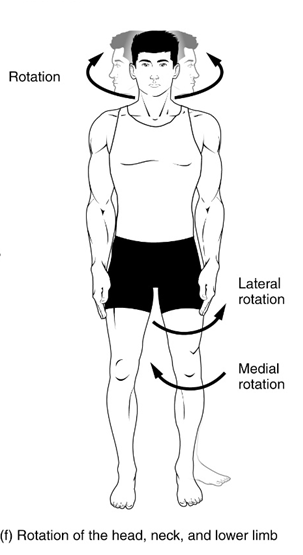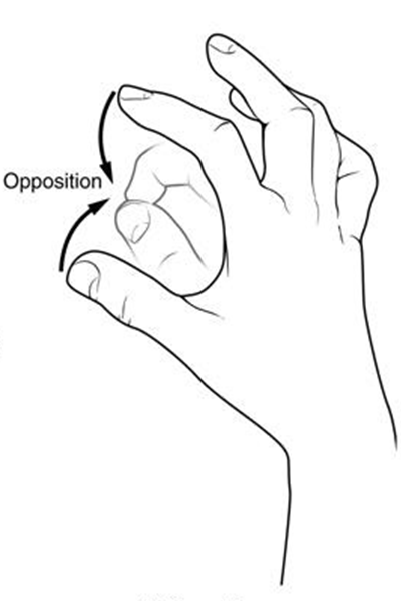10.2: Body Movements
- Page ID
- 53670
\( \newcommand{\vecs}[1]{\overset { \scriptstyle \rightharpoonup} {\mathbf{#1}} } \)
\( \newcommand{\vecd}[1]{\overset{-\!-\!\rightharpoonup}{\vphantom{a}\smash {#1}}} \)
\( \newcommand{\id}{\mathrm{id}}\) \( \newcommand{\Span}{\mathrm{span}}\)
( \newcommand{\kernel}{\mathrm{null}\,}\) \( \newcommand{\range}{\mathrm{range}\,}\)
\( \newcommand{\RealPart}{\mathrm{Re}}\) \( \newcommand{\ImaginaryPart}{\mathrm{Im}}\)
\( \newcommand{\Argument}{\mathrm{Arg}}\) \( \newcommand{\norm}[1]{\| #1 \|}\)
\( \newcommand{\inner}[2]{\langle #1, #2 \rangle}\)
\( \newcommand{\Span}{\mathrm{span}}\)
\( \newcommand{\id}{\mathrm{id}}\)
\( \newcommand{\Span}{\mathrm{span}}\)
\( \newcommand{\kernel}{\mathrm{null}\,}\)
\( \newcommand{\range}{\mathrm{range}\,}\)
\( \newcommand{\RealPart}{\mathrm{Re}}\)
\( \newcommand{\ImaginaryPart}{\mathrm{Im}}\)
\( \newcommand{\Argument}{\mathrm{Arg}}\)
\( \newcommand{\norm}[1]{\| #1 \|}\)
\( \newcommand{\inner}[2]{\langle #1, #2 \rangle}\)
\( \newcommand{\Span}{\mathrm{span}}\) \( \newcommand{\AA}{\unicode[.8,0]{x212B}}\)
\( \newcommand{\vectorA}[1]{\vec{#1}} % arrow\)
\( \newcommand{\vectorAt}[1]{\vec{\text{#1}}} % arrow\)
\( \newcommand{\vectorB}[1]{\overset { \scriptstyle \rightharpoonup} {\mathbf{#1}} } \)
\( \newcommand{\vectorC}[1]{\textbf{#1}} \)
\( \newcommand{\vectorD}[1]{\overrightarrow{#1}} \)
\( \newcommand{\vectorDt}[1]{\overrightarrow{\text{#1}}} \)
\( \newcommand{\vectE}[1]{\overset{-\!-\!\rightharpoonup}{\vphantom{a}\smash{\mathbf {#1}}}} \)
\( \newcommand{\vecs}[1]{\overset { \scriptstyle \rightharpoonup} {\mathbf{#1}} } \)
\( \newcommand{\vecd}[1]{\overset{-\!-\!\rightharpoonup}{\vphantom{a}\smash {#1}}} \)
Body Movements
There are general anatomical terms that can be used to describe most movements the body makes. Most terms have a clear opposite, and so are treated in pairs. These pairs include:
- flexion - extension
- abduction - adduction
- circumduction (no opposite)
- elevation - depression
- internal/medial rotation - external/lateral rotation
- dorsiflexion - plantar flexion
- pronation - supination
- inversion - eversion
- protrusion/protraction - retrusion/retraction
- opposition - reposition
Flexion & Extension
Flexion and extension describe movements that affect the angle between two parts of the body. Flexion describes a bending movement that decreases the angle between a segment and its proximal segment. Extension is the opposite of flexion, describing a straightening movement that increases the angle between body parts
Abduction & Adduction
Abduction is the motion of a structure away from the midline while adduction refers to motion towards the center of the body. The center of the body is defined as the midsagittal plane. These terms come from Latin words with similar meanings, ab- being the Latin prefix indicating "away," ad- indicating "toward," and ducere meaning "to draw or pull" (cf. English words "duct," "conduct," "induction"). Abduction refers to a motion that pulls a structure or part away from the midline of the body. In the case of fingers and toes, it refers to spreading the digits apart, away from the centerline of the hand or foot. Adduction refers to a motion that pulls a structure or part toward the midline of the body, or towards the midline of a limb.
Circumduction
Circumduction refers to a conical movement of a body part, such as a ball and socket joint or the eye. Circumduction is a combination of flexion, extension, adduction and abduction. Circumduction can be best performed at ball and socket joints, such as the hip and shoulder, but may also be performed by other parts of the body such as fingers, hands, feet, and head.
Elevation & Depression
The terms elevation and depression refer to movement above and below the horizontal. Elevation refers to movement in a superior direction. Depression refers to movement in an inferior direction, the opposite of elevation.
Internal/Medial Rotation & External/Lateral Rotation
Rotation of body parts is referred to as internal or external, referring to rotation towards or away from the center of the body. Internal rotation (or medial rotation) refers to rotation towards the axis of the body. External rotation (or lateral rotation) refers to rotation away from the center of the body.

Dorsiflexion & Plantar Flexion
Dorsiflexion and plantar flexion refer to extension or flexion of the foot at the ankle. These terms refer to flexion in direction of the "back" of the foot, dorsum pedi, which is the upper surface of the foot when standing, and flexion in direction of the sole of the foot, plantar pedi. These terms are used to resolve confusion, as technically extension of the joint refers to dorsiflexion, which could be considered counter-intuitive as the motion reduces the angle between the foot and the leg. Dorsiflexion is where the toes are brought closer to the shin. This decreases the angle between the dorsum of the foot and the leg. Plantar flexion or plantarflexion is the movement which decreases the angle between the sole of the foot and the back of the leg.
Pronation & Supination
Pronation and supination refer most generally to assuming prone or supine positions, but often they are used in a specific sense referring to rotation of the forearm or foot so that in the standard anatomical position the palm or sole is facing anteriorly (supination) or posteriorly (pronation). Pronation at the forearm is a rotational movement where the hand and upper arm are turned inwards. Pronation of the foot refers to turning of the sole outwards, so that weight is borne on the medial part of the foot. Supination of the forearm occurs when the forearm or palm are rotated outwards. Supination of the foot refers to turning of the sole of the foot inwards, shifting weight to the lateral edge.
Inversion & Eversion
Inversion and eversion refer to movements that tilt the sole of the foot away from (eversion) or towards (inversion) the midline of the body. Eversion is the movement of the sole of the foot away from the median plane. Inversion is the movement of the sole towards the median plane.
Protrusion/Protration & Retrusion/Retraction
Protrusion and retrusion are sometimes used to describe the anterior (protrusion) and posterior (retrusion) movement of the jaw. Protraction and retraction refer to an anterior (protraction) or posterior (retraction) movement, such as of the arm at the shoulders, and the mandible.
Opposition & Reposition
Opposition refers to the movement that involves grasping of the thumb and fingers. Reposition refers to restoring an object to its natural condition.

Attributions
- "Anatomy and Physiology" by J. Gordon Betts et al., OpenStax is licensed under CC BY 4.0
- "Anatomy and Physiology I Lab" by Victoria Vidal is licensed under CC BY 4.0


